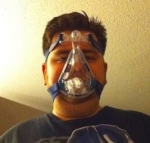I don't pretend to understand it either, but for Flow Information to be meaningful, you need to look at a much smaller frame of time, eg, 5 minutes or less. There's some good info here:
http://www.osahelp.com/
Here's a link to the ResMed Data Management Guide:
http://www.resmed.com/uk/assets/documen ... ow_eng.pdf
I only ook at Flow in context with what my leak rate is
at that moment, or if there is an apnea or hypopnea happening.
When I look at my data I look for:
- Leaks--liter/minute. My leaks are generally 0-4 liters/minute at the 95th percentile. You may have read already, that anything approaching 24 liters/minute affects accuracy of data, and the ability of the cpap to compensate. Also, leaks can disturb your sleep, so you don't get restful sleep.
- Nature of leaks, and whether they're sporadic (occasional adjusting mask for leaks), or continuous (long period of mask leak), and whether they coincide with any events, and how can I prevent those.
- Obstructive apneas, and what my pressure was, immediately prior to it, and how the apap responded by raising the pressure. I get a few central apneas during the night, but don't worry about them.
- Clusters of obstructive apneas, and whether they were positional--if I recall waking up in supine position. Or if obstructive apneas are during REM sleep, usually 1 1/2 hours after sleep onset (or longer as the night goes one).
I think it's all good information, but really, you're looking for trends, ie are your leak rates going down as you become more used to therapy, are you sleeping for longer periods with less wake-ups, is your AHI consistent or getting lower. Keep in mind that there will always be the occasional bad night due to stress or poor sleep hygiene.











